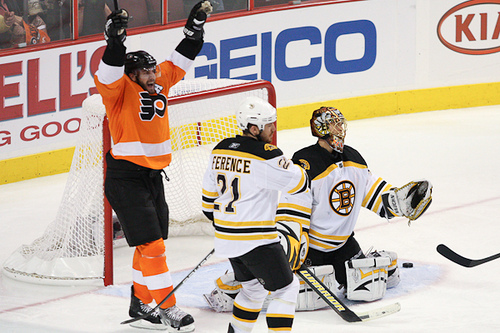
 Jeremy King
The Hockey Writers
Jeremy King
The Hockey Writers
39
Reads
0
Comments
Demystifying the Bruins’ 2013 Game 7 Comeback
When ranking the greatest comebacks in hockey history, one would be hard-pressed to find a game that receives more praise and adulation than the Boston Bruins’ Game 7 comeback against the Toronto Maple Leafs. In the first round of the 2013 Stanley Cup playoffs, the Bruins rallied to overcome a 4-1 deficit with just 10:42 left to play in regulation. While many consider this to be one of the greatest comebacks in NHL history, the underlying numbers paint a different picture. Although the Bruins were the first team in NHL history to win a Game 7 after trailing by three in the third, that feat loses some of its luster when the series is examined in its entirety.
A Brief History
In terms of the comeback itself, rallying back from a three-goal deficit is not quite as rare you might think. Over the course of NHL history, numerous teams have mounted such a comeback, including nearly 200 instances occurring in a minute or less. In fact, in 1952, New York Ranger Bill Mosienko scored three times in only 21 seconds for the fastest hat trick in history. Even the Bruins once astonishingly notched three short-handed markers in just 64 seconds in the spring of 2010.
Related: NHL Hat Tricks History & Fun Facts
Later in that 2010 postseason, the B’s themselves fell victim to such a comeback, surrendering four straight goals to Philadelphia in Game 7 of the Eastern Conference Semifinal. While the timing of the Bruins’ third-period comeback may have been historic, ultimately they should have been able to polish off the Leafs well before that point.

Heading into the series, the Bruins were heavily favored. They had finished the lockout-shortened 2012-13 campaign with 62 points, locking in fifth overall. Conversely, the Leafs had finished tied for ninth overall with 57 points, just two points into a playoff spot. The two teams had met four times that season, with the Bruins taking home six of a possible eight points. All signs heading into the series pointed to a swift and decisive victory for the Bruins.
That’s Offensive
While the Leafs may have entered the series with a slight statistical advantage offensively, a deep dive into the numbers reveals that this may in fact have simply been the result of the shortened schedule. Although Toronto tallied 18 more goals than the Bruins throughout the regular season, this disparity can be linked to unsustainable fluctuation in shooting percentage. Each of Toronto’s top five goal-scorers experienced an increased shooting percentage when compared to the rest of their careers. Nazem Kadri (+5.4 percent), Tyler Bozak (+6.9 percent), and Joffrey Lupul (+15.4 percent) in particular, scored at much higher rates than would be expected based on their career production.
Related: 7 Best Rookie Seasons in Boston Bruins History
By comparison, Nathan Horton (-3.4 percent), David Krejci (-1.8 percent), and Patrice Bergeron (-2.9 percent) all experienced a decline in shooting percentage, resulting in fewer goals scored overall.

Toronto’s perceived offensive advantage was likely the result of the abbreviated NHL season, as each team’s top producers would have settled in much closer to their career average, had the season been played in full.
A Tale of Two Goaltenders
As the two teams were quite evenly matched offensively, the Bruins’ defensive superiority should have propelled them to victory long before Game 7. Boston ranked third overall in goals against during the regular season, allowing 22 fewer goals than the 17th-ranked Maple Leafs. Additionally, only four Bruins skaters carried a minus rating entering the playoffs, compared to 11 Toronto players (minimum seven GP). A major reason for this defensive dominance was the performance of the man between the pipes, Tuuka Rask.
Boasting a sterling .929 save percentage, 2.00 goals-against average, and five shutouts, Rask bested Toronto’s James Reimer in nearly every statistical category during the regular season. Despite appearing in three additional games, Rask allowed six fewer goals than the Leafs’ netminder. The disparity between the two becomes even more prevalent when examining underlying analytic data, such as quality start percentage. In this category, Rask (.735 quality start percentage) was absolutely dominant, performing above league-average nearly 19 percent more often than Reimer (.548 quality start percentage). In a league where goaltending often determines playoff success, the Bruins definitively held the upper hand entering the Round 1 matchup.
That’s My Puck, Baby
In addition to their advantage on the defensive and goaltending fronts, the Bruins also played a vastly superior two-way game. Led by Bergeron, a four-time Selke Trophy winner, the B’s possession metrics were among the very best in the league. Although Toronto blocked 126 more shots, and threw a whopping 426 more hits, many in the hockey community now view these as indicators of poor two-way play.
Related: The 5 Greatest Goaltenders in NHL History
Basically, you don’t need to block shots or lay the body if you already have the puck… looking at you, Komarov. Toronto ranked 24th in shot attempts for, and dead last in shot attempts against and shot attempt differential, resulting in an abysmal 44.1 Corsi For percentage. The B’s on the other hand, finished third overall with a Corsi For of 53.4 percent. That’s Happy Gilmore-level puck possession, folks.

These numbers become even more impressive when we look at those expected to really carry the mail for their respective clubs come playoff time. Boston’s top four defencemen held a 9.7 percent Corsi advantage over the Leafs’ defenders, while their top-six forwards maintained an astonishing 13.2 percent lead over their counterparts in the Blue and White. When you throw in Boston’s 6.3 percent edge in the faceoff circle, you can easily see why the Bruins’ remarkable possession game should have given them a clear-cut advantage over their division rival.
Out the Window
Ultimately, the fact that the Bruins were able to mount a three-goal comeback in the third period of a Game 7 is undeniably historic. While many other teams and even other players have scored more goals in less time, the fact that the feat occurred in the final frame of the most pivotal game of the series, earns the comeback its place in history.
Timing aside, however, the Bruins should have never been in a position to require such a historic comeback. Entering the series as the heavy favorite, and with opportunities to eliminate Toronto in Games 5 and 6, Boston should have been able to dispatch their opponent well before a deciding Game 7. Even though the Buds and the B’s were relatively even offensively, the Bruins were substantially better defensively, in goal, and dominated the possession game. While Bruins fans should celebrate the comeback as a stepping stone on the road to the Cup Final, it should also serve as a reminder that regular-season success goes out the window come playoff time.
The post Demystifying the Bruins’ 2013 Game 7 Comeback appeared first on The Hockey Writers.
Popular Articles

















































 Blackhawks Chicago
Blackhawks Chicago Panthers Florida
Panthers Florida Penguins Pittsburgh
Penguins Pittsburgh Rangers New York
Rangers New York Avalanche Colorado
Avalanche Colorado Kings Los Angeles
Kings Los Angeles Maple Leafs Toronto
Maple Leafs Toronto Bruins Boston
Bruins Boston Capitals Washington
Capitals Washington Flames Calgary
Flames Calgary Oilers Edmonton
Oilers Edmonton Golden Knights Vegas
Golden Knights Vegas Senators Ottawa
Senators Ottawa Lightning Tampa Bay
Lightning Tampa Bay Flyers Philadelphia
Flyers Philadelphia Islanders New York
Islanders New York Sabres Buffalo
Sabres Buffalo Red Wings Detroit
Red Wings Detroit Devils New Jersey
Devils New Jersey Hurricanes Carolina
Hurricanes Carolina Blue Jackets Columbus
Blue Jackets Columbus Predators Nashville
Predators Nashville Wild Minnesota
Wild Minnesota Blues St. Louis
Blues St. Louis Stars Dallas
Stars Dallas Jets Winnipeg
Jets Winnipeg Mammoth Utah
Mammoth Utah Sharks San Jose
Sharks San Jose Canucks Vancouver
Canucks Vancouver Ducks Anaheim
Ducks Anaheim


